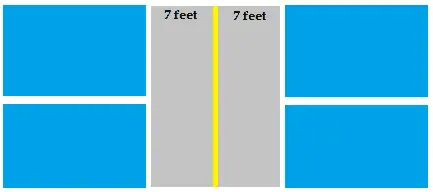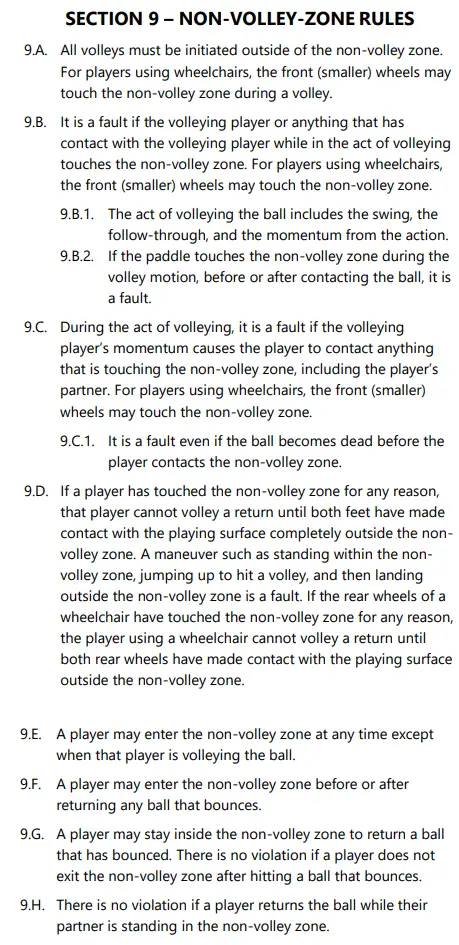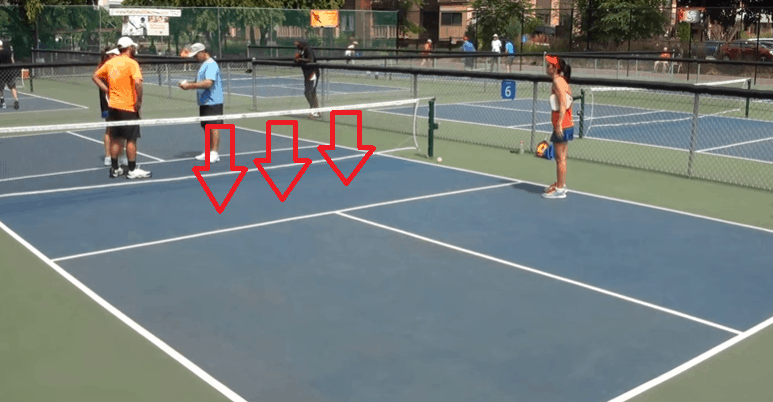One of the most unique things about pickleball, other than the wacky history of how it got its name, is the non-volley zone or the pickleball kitchen as it’s popularly called. In this piece, we will drill down the basics of what is a pickleball kitchen, the history behind its name, the rules and myths associated with the kitchen and a general run-down of the strategies for the non-volley zone.
I should have probably mentioned this in my list of reasons why I play pickleball, but one of the first aspects of the game which attracted me to it was the term ‘pickleball kitchen’; it added some sort of a mystery to the sport.
Now we all know pickleball has traces of tennis, table tennis and badminton in it but none of these mentioned sports or even other racket sports, have an aspect of the game like pickleball does with its kitchen.
It makes the pickleball rules a unique set, making it a curiosity-appealing form that attracts more fans.
Let’s drill down to what, why, how, when and where of a pickleball kitchen then. Before that, however, a quick reminded you can also read this piece here if you are looking for pickleball courts of your choice around you.
Table of Content
What’s the Kitchen in Pickleball?
This is a small box on either side of the net in a game of pickleball in which a player isn’t allowed to volley; i.e. one cannot jump into the kitchen and hit the ball on the full, instead needs to allow it to bounce before playing a shot.
Now, you might have a question here – what does a volley mean?
A volley is an oft-used term in sport which denotes the hitting of a ball before it’s hit the ground. In racket sports, a volley is the act of a strike using your rackets before the ball has struck the ground while in soccer, it’s doing the same using your foot.
What this means is that when you are in a kitchen area in pickleball you cannot hit the ball on a volley, i.e. you are only allowed to play it after it’s bounced once. This doesn’t apply when you are outside the kitchen, in which case a pickleball can be volleyed back to your opponent.
Also Read:
Where is the Pickleball Kitchen Located?
If you are looking to understand the pickleball kitchen or the non-volley zone, it’s a box which extends seven feet on both sides of the net, forming a rectangle with the sidelines.
The surface in grey below, seven feet on both sides of the net, is where the kitchen is located.

Why is the Non-Volley Zone Called a Kitchen?
Not a lot is known about how the non-volley zone, i.e. seven feet on either side of the net, came to be known as the kitchen but there’s a chain of thought which reckons the term comes from the sport of Shuffleboard, in which the kitchen is the name given to the 10 OFF zone which is also the penalty zone if a player puck lands there.
There’s another interesting theory about this.
As mentioned earlier, the sport of pickleball was named so because the inventor’s dog’s name was Pickles and the legend has it, the dog wasn’t allowed inside the kitchen! Ha.
A kitchen is one of the many such terms used in pickleball and if you are just starting out and want to understand all about pickleball, here’s more on terms and phrases used in pickleball to make you sound like a pro.
Pickleball Kitchen Rules
The most basic rule associated with the pickleball kitchen is a player standing in the kitchen or touching the kitchen line, isn’t allowed to play a volley.
A volley is the term used to describe a shot which is played by pickleball (or tennis) players when they don’t allow the ball to bounce even once. In short, if a player is standing in the kitchen or touching the kitchen line, he/she needs to allow the ball to bounce once before playing the shot.
Here’s the complete set of rules associated with the pickleball kitchen, according to USA Pickleball Official Rulebook.

Why is Volleying in the Kitchen a Violation?
The rule makes perfect sense too.
Unlike tennis, where there are no such non-volley zones, a pickleball court is smaller and the ball is lighter, thereby making a volley an easy smash if played from very close to the net.
Without the kitchen, there would barely be any rallies with players getting close to the net and smashing everything away.
However the above explanation is a very simplistic one. There are more rules associated with the pickleball kitchen and those can be explained below.
How to Play Pickleball in the Kitchen?
Volleying While Standing in the Kitchen
As mentioned earlier, a player standing inside the pickleball kitchen cannot play a volley or a fault will be called.
Volleying with Foot Touching the Kitchen Line
If a player is outside the kitchen but at least one foot touches the kitchen line, a volley cannot be played again. In short a player needs to be fully outside the non-volley zone, as the kitchen is also called.
Momentum after Volleying
The official rule-book of the International Federation of Pickleball (IFP) also states the following:
“A fault will be declared if, in the act of volleying the ball, the player’s momentum causes the player or anything the player is wearing or carrying to touch the non-volley zone or touch any non-volley line. It is a fault if the player’s momentum causes the player to touch anything that is touching the non-volley zone, including the player’s partner. It is a fault even if the ball is declared dead before the player touches the non-volley zone.”
A player who falls over into the kitchen or touches the kitchen line after playing a volley will also have a fault called out according to this rule. If this same momentum gets a player to lose his/her racket or even if something falls off his/her self like a cap or keys into the kitchen, a fault would be called.
If you have played tennis, this is similar to a player being not allowed to touch the net while running in to play a drop shot.
Also Read:
Volleying When in the Air
This is an interesting one.
A player is allowed to volley if he/she is outside the kitchen, jumps up and plays the shot but continues to remain outside the non-volley zone even if the jump took him in the space above the kitchen. As long as the player doesn’t violate the aforementioned rules, it is fine.
However, what a player cannot do is to jump into the kitchen, then jump in the air and play the volley and rush back outside the kitchen.
The rules mandate a player to begin the process of playing the volley from outside the kitchen as well, which implies if a player has jumped into the kitchen, he/she would need to get back outside the non-volley zone before playing the volley.
Volleying While Outside the Kitchen
So the other obvious question is if you can volley with your feet outside the kitchen but the ball in the air and perceptibly above the kitchen. The answer to this is yes, you can,
The kitchen is a 2D area and not a 3D one which means as long as you have your feet and body outside the non-volley zone, you can volley the ball back even if it’s still in the space above the kitchen.
Where to Stand While Volleying in Pickleball?
Essentially, if you cannot volley in the kitchen, the best strategy to use is to stand a few inches behind the non-volley zone line. Don’t touch the line obviously and give yourself those few inches to allow for any momentum-related balance issues but don’t get too far from the line either.
When you are just starting out, there is a good chance you might miss out on where the kitchen line is.
There could be regular occasions when you end up transgressing the aforementioned rules even if you are standing those few inches away from the non-volley zone but the key is to keep practicing.
Muscle memory is an amazing thing and the more you practice, the more you will get used to developing your instincts about the non-volley zone.
Inside the Pickleball Kitchen
Well, if you are inside the kitchen, you can play groundstrokes, but more importantly, it’s a good place to dink the ball back at your opponent.
Here’s more on what is a dink in pickleball, but to give a brief recap, it’s a strategy to slow the pace of the game with gentle tap back at your opponent instead of playing aggressive groundstrokes.
The trouble is, once you are inside the kitchen even if to play a dink or other groundstrokes, you need to think of getting out of there or you could land into trouble.
It would make easier for the opponent to aim a shot anywhere over the kitchen line, making it nearly improbable for you to return since you cannot play a volley from where you are!
Pickleball Kitchen FAQs
To explain the above rules in a gist, here’s a set of frequently asked questions associated with the pickleball kitchen or the non-volley zone.
Can one play a volley standing in the kitchen?
No, volleying in the kitchen is a fault and a player can only volley from outside the kitchen.
Can one play a volley with a foot touching the kitchen line?
No, a volley with any portion of the foot touching the kitchen line is a fault.
Is it okay if some equipment of a player falls into the kitchen while or after playing a volley?
If a player drops his cap or shoe or anything else from his pocket into the kitchen or touching the kitchen line while or after playing a volley, it would be considered a fault
Can a player touch his racket inside the kitchen while or after playing a volley?
Again, no, a player’s racket isn’t allowed to touch any part of the kitchen while or after playing a volley.
Can a player play a volley from outside the kitchen but end up touching his/her partner who is inside the kitchen or touching the kitchen line?
No, a player playing a volley cannot touch his/her partner who is in the non-volley zone or touching the kitchen line.
Can a player play a volley from outside the kitchen and then move into the kitchen immediately after playing the shot?
No, if a player plays a volley and then loses momentum and trudges on to the kitchen, it would be called a fault. This rule applies to anything a player is wearing or carrying as well.
Can a player play a volley and move into the kitchen after the ball has gone dead at the other end?
Again, no, even if the ball goes dead after a volley is played but the player playing the volley jumps into the kitchen because of the momentum, it would be called a fault against the player/team playing the volley.
Can I jump into the kitchen and then jump in the air, play a volley and jump back outside the kitchen?
No, the process of playing a volley in pickleball must start outside the pickleball kitchen. If a player is inside the kitchen, he/she needs to first get outside the kitchen, and only then can play a volley without it being deemed a fault.
Can I volley from outside the kitchen even if the ball is in the air over the kitchen?
Yes, you can. As mentioned earlier, the kitchen is a 2D area and as long as you continue to remain outside of the kitchen, you can volley even if the ball’s in the air above the kitchen.
When can a player play from the kitchen?
A player can be inside the kitchen at any time he/she wants but with the obvious caveat there cannot be a volley played. Strategically, however, it makes sense to only get into the kitchen while making a return to a shot that’s being dinked back before returning back to the safety of outside the kitchen.


